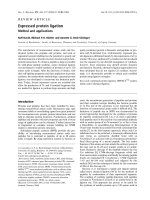TELEMEDICINE TECHNIQUES AND APPLICATIONS docx
Bạn đang xem bản rút gọn của tài liệu. Xem và tải ngay bản đầy đủ của tài liệu tại đây (34.4 MB, 514 trang )
TELEMEDICINE
TECHNIQUES AND
APPLICATIONS
Edited by Georgi Graschew
and Stefan Rakowsky
Telemedicine Techniques and Applications
Edited by Georgi Graschew and Stefan Rakowsky
Published by InTech
Janeza Trdine 9, 51000 Rijeka, Croatia
Copyright © 2011 InTech
All chapters are Open Access articles distributed under the Creative Commons
Non Commercial Share Alike Attribution 3.0 license, which permits to copy,
distribute, transmit, and adapt the work in any medium, so long as the original
work is properly cited. After this work has been published by InTech, authors
have the right to republish it, in whole or part, in any publication of which they
are the author, and to make other personal use of the work. Any republication,
referencing or personal use of the work must explicitly identify the original source.
Statements and opinions expressed in the chapters are these of the individual contributors
and not necessarily those of the editors or publisher. No responsibility is accepted
for the accuracy of information contained in the published articles. The publisher
assumes no responsibility for any damage or injury to persons or property arising out
of the use of any materials, instructions, methods or ideas contained in the book.
Publishing Process Manager Ana Pantar
Technical Editor Teodora Smiljanic
Cover Designer Jan Hyrat
Image Copyright 26kot, 2010. Used under license from Shutterstock.com
First published July, 2011
Printed in Croatia
A free online edition of this book is available at www.intechopen.com
Additional hard copies can be obtained from
Telemedicine Techniques and Applications, Edited by Georgi Graschew and Stefan
Rakowsky
p. cm.
ISBN 978-953-307-354-5
free online editions of InTech
Books and Journals can be found at
www.intechopen.com
Contents
Preface IX
Part 1 Theoretical and Practical Foundations
of Telemedicine Techniques 1
Chapter 1 Innovative Medical Devices for
Telemedicine Applications 3
Agostino Giorgio
Chapter 2 Pervasive Homecare Monitoring
Technologies and Applications 45
Demosthenes Vouyioukas
and Alexandros Karagiannis
Chapter 3 Wireless Telemedicine System: An Accurate,
Reliable and Secure Real-time Health Care 71
Huyu Qu, Le Yi Wang, Christopher M. Klaus,
Qiang Cheng, Ece Yaprak
and Hong Wang
Chapter 4 Design Criteria for Large
eHealth Infrastructure Systems 99
Thomas Grechenig, Barbara Avana, René Baranyi,
Wolfgang Schramm and Anna Wujciow
Chapter 5 QoS in Telemedicine 119
Phumzile Malindi
Chapter 6 On Redefining Telemedicine Paradigm:
An Innovative Integrated Model for
Efficient Implementation of Healthcare
Delivery in Developing Countries 139
K.V.Sridhar and K.S.R.Krishna Prasad
Chapter 7 Novel Prediction Based Technique for Efficient
Compression of Medical Imaging Data 169
Josip Knezović, Mario Kovač, Martin Žagar,
Hrvoje Mlinarić and Daniel Hofman
VI Contents
Chapter 8 Clinical Decision Support Systems 185
Dejan Dinevski, Uroš Bele, Tomislav Šarenac,
Uroš Rajkovič and Olga Šušteršič
Chapter 9 A 2.4GHz Non-Contact Biosensor System
for Continuous Monitoring of Vital-Signs 211
Donald Y.C. Lie, Ravi Ichapurapu, Suyash Jain,
Jerry Lopez, Ronald E. Banister, Tam Nguyen and John Griswold
Part 2 Application Scenarios and Case Studies 239
Chapter 10 Mobile Web Application Development
to Access to Psychiatric Electronic Health Records 241
Isabel de la Torre Díez, Míriam Antón-Rodríguez
and Francisco J. Díaz-Pernas
Chapter 11 Clinical Psychology and Medicine for the Treatment
of Obesity in Out-patient Settings: the TECNOB Project 257
Gianluca Castelnuovo, Gian Mauro Manzoni
, Stefania Corti,
Paola Cuzziol, Valentina Villa and Enrico Molinari
Chapter 12 The Role of Standard 12-lead ECG
in a Telecardiology Consultation Service 269
Kjell Nikus, Vesa Virtanen,
Samuel Sclarovsky and Markku Eskola
Chapter 13 Tele Oncology for Cancer Care in Rural Australia 289
Sabe Sabesan
and Sean Brennan
Chapter 14 Telemedicine in the Diagnosis and
Management of Congenital Heart Disease 307
Brian McCrossan and Frank Casey
Chapter 15 Telemedicine for Managing
Patients on Oral Anticoagulant Therapy 331
Sophie Testa, Oriana Paoletti, Anke Zimmermann,
Laura Bassi and Emilia Cancellieri
Chapter 16 Telemedicine for Chronic Digestive
Diseases: A Systematic Qualitative Review 347
Sandra M. Quezada and Raymond K. Cross
Chapter 17 Teledermatology: Outcomes
and Economic Considerations 363
Akhilesh S. Pathipati and April W. Armstrong
Chapter 18 Screening for Retinopathy of Prematurity 379
Claire Hartnett and Michael O’Keefe
Contents VII
Chapter 19 Teleophthalmology 393
Manoj Kulshrestha, Simon P Kelly
and Usman Mahmood
Chapter 20 Telemedical Solutions -
Practical Approach in Bulgaria 413
Polina Mihova
Chapter 21 Practical Results of Telemedicine
System Between Antarctic Station and Japan 439
Giichiro Ohno
Chapter 22 Telestroke for the Long-term
Management of Risk Factors in Stroke Survivors 453
Joubert J, Medeiros de Bustos E, Decavel P,
Chopard JL, Joubert LB and Moulin T
Chapter 23 The Role of Telemedicine in the Management
of Acute Trauma Referrals to a Regional Plastic
and Hand Surgery Unit in the South East of England 475
David Wallace and Mark Pickford
Preface
Telemedicine is not a novelty. The first transmission of patient-relevant data dates
back several decades. Respective technologies have been developed rapidly since their
introduction and extended application of digital medicine, so today medical data are
more and more stored digitally. As we increasingly speak of the paperless hospital, it
has become easier to use services such as the Internet and the newly established Web
2.0 as well as Ipv6 to enable the use of applications such as eHealth, ePrescription, and
homecare. Several chapters (1-9) in Part I of this book are devoted to practical and the-
oretical foundations of telemedicine techniques. A number of chapters (10-23) in Part II
demonstrate impressive and manifold application examples from practice as well as
case studies.
Part I. Theoretical and Practical Foundations of Telemedicine Techniques
The first chapter Innovative Medical Devices for Telemedicine Applications describes
several devices which were invented, especially designed, successfully tested and pa-
tented by the author. The first applications are remote health monitoring via a wireless
(bluetooth/Zigbee and UMTS/GPRS) transmitter of vital parameters acquired by sev-
eral probes for ECG, Blood Glucose, physical activity, breathing frequency, blood
pressure, etc.). The use of a tele-stethoscope for the objectivation of cardio-pulmonary
auscultation, a Pain Button / Wireless Pain Button for the provision of extended moni-
toring of patients with high risk, an RFID-based system allowing doctors easier and
quicker access to patient data and PC-based system for remote medical visits allowing
the doctor a complete cardio-respiratory control of a remote patient in real-time are
important for advanced homecare.
The chapter Pervasive Homecare Monitoring Technologies and Applications gives a
comprehensive overview of homecare technology, applications and implementation of
wireless technologies which enable pervasive homecare monitoring of elderly, chroni-
cally ill (and children). Most existing solutions include a BAN of sensors carried by the
patient and environmental sensors forming a PAN connected to the monitoring site by
a gateway. The chapter presents detailed analysis of wireless sensor standards
(IEEE802.15.4, ZigBee, etc), sensor types including physiological, biokinetic and ambi-
ent sensors and signal processing as well as techniques to reduce energy consumption.
X Preface
A mathematical model for the accuracy and reliability of a communication system for
the transmission of vital patient signals in remote health monitoring is given in the
chapter Wireless Telemedicine System: An Accurate, Reliable and Secure Real-time
Health Care. Transmission errors are analysed based on a WLAN (802.11b) integrated
system. The relationships are studied in a simulation of a remote medical diagnosis of
typical lung sounds yielding a trade-off between resource consumption and
information accuracy. The chapter analyses the security of wireless channels in case of
attacks and discusses the enhancement of security.
In Design Criteria for Large eHealth Infrastructure Systems the authors analyse the
criteria to be considered before the setup of a nationwide or large eHealth
infrastructure. The authors distinguish between the political, institutional, operational
and technical level and respective design criteria. On the political level cultural
aspects, innovation, healthy growing of the intended system, fears and acceptance by
the users and representation in parliament and legislative measures have to be
considered. On the institutional level the system acceptance by primary and secondary
healthcare centers, health insurance companies, hospitals, pharmacies, nursing homes
and patients was analysed. Benefits and costs of the intended system have to be
considered against requirements and wishes. On the operational level the actual
administration of the eHealth system comes into play through adaptability of the
system, accessibility of patient data, maintainability of the network, interoperability of
heterogeneous systems and transparency of data transmission.
In the chapter QoS in Telemedicine we learn that Quality of Service (QoS) in IP-based
telemedicine systems is required for the delivery of services like tele-consultation, tele-
diagnosis, tele-monitoring or tele-education. QoS is determined by delay, jitter, bit rate
and packet loss of the network. The author analyses the methods for ensuring quality
transmission: traffic differentiation, traffic engineering, error control and data
encoding. The emphasis is on traffic differentiation using DiffServ and MPLS and the
evaluation of the performance of the proposed solutions.
In the chapter On Redefining Telemedicine Paradigm: An Innovative Integrated
Model For Efficient Implementation Of Healthcare Delivery In Developing Countries,
by taking into account the healthcare situation in highly populated developing
countries such as India and China, the authors redefine the goal of telemedicine as
increasing the doctor to patient ratio. It will also be important to reduce the number of
patients by introducing preventive healthcare which is also supported by
telemedicine. To achieve this, the authors suggest a new approach to keep medical
records and start to develop it. They propose a secure and interoperable Electronic
Health Record, collecting data in a single file, allowing real time updates, compression
of medical data and dynamic transmission of data.
In Novel Prediction Based Technique for Efficient Compression of Medical Imaging
Data a predictive model for lossless image compression is described and evaluated.
Predictive image coding can be formulated as composed of prediction of a pixel based
Preface XI
on surrounding pixels, contextual modeling of the prediction error and entropy coding
of the prediction error. The proposed model uses classification and blending of static
predictors followed by heuristic contextual error modeling. The description of the
predictive coding method is followed by a presentation of experimental results of the
two developed complete lossless image codecs. The resulting compression of medical
imaging data could be applied for reducing required transmission in telemedical ap-
plications and storage of digital image data.
The chapter Clinical Decision Support Systems gives a theoretical background of clini-
cal decision support systems in decision making and qualitative clinical decision anal-
ysis. The structure of various clinical decision support systems is characterized well
(e.g., according to knowledge-based systems or expert systems and non knowledge-
based systems that use machine learning such as in neural networks). The success fac-
tors of clinical decision support systems are improved patient safety, quality of care
and efficiency of healthcare. The chapter closes with examples of clinical decision sup-
port systems in practice and a close look on the example of good practice of clinical
decision support system in telemedicine for evaluation of patient health in nursing
care.
In the chapter A 2.4 GHz Non-Contact Biosensor System for Continuous Monitoring of
Vital-Signs a novel Doppler-radar-based sensor for non-contact detection of respira-
tion and heartbeat rate is presented. The system is composed of off-the-shelf parts and
comprises a LabVIEW graphical user interface taking over the discrete Fourier trans-
form of the waveforms. The theoretical background for the chosen method of Doppler
radar along with the transceiver architecture and results for the measured vital signs
with different generations of the sensor are presented and the data and errors ana-
lysed.
Part II. Application Scenarios and Case Studies
In the chapter Mobile Web Application Development to Access to Psychiatric
Electronic Health Records a mobile web application (EHR mobile) has been developed
based on HL7/CDA and JAVA Servlet and JSP technologies to access electronic health
records (EHC) from a PC and with mobile devices. A system overview and detailed
data modeling and architecture is given, followed by a description of the user interfac-
es for different modules of the application which opens new possibilities for infor-
mation access counselling and cooperation of health professionals. Standards for pri-
vacy and confidentiality have been verified.
The chapter Clinical Psychology and Medicine for the Treatment of Obesity in Out-
patient Settings: The TECNOB Project presents the TECNOB project designed to de-
termine which features of telemedicine are critical in a cost effective approach. A two
step approach is chosen to treat weight loss and maintenance of obese patients consist-
ing of a hospital-based intensive treatment and an out-patient phase supported by tel-
emedicine. In the outpatient phase the patients wear a multisensory armband which
XII Preface
monitors their physical activity and have access to the TECNOB web-platform with
questionnaires, food record diary, administrative functions and videoconference facili-
ty. Through mobile phone the patients can stay in contact with their dietician and in
scheduled videoconference sessions with clinicians.
In The Role of Standard 12-lead ECG in a Telecardiology Consultation Service the set
up of a telecardiology consultation service and evaluation in a patient study phase is
described. A Personal Information Repository document service has been replaced by
an internet-based consultation system used for posting consultation requests and stor-
ing ECG´s for analysis by the consulting cardiologist. In a real time interactive tele
ECG consultation the physician is connected to the consulting expert while the patient
is still in the doctor´s office. This technology could make the service more profitable.
In the chapter Tele Oncology for Cancer Care in Rural Australia it is stated that to im-
prove the access to the quality oncological care in rural areas without larger treatment
centers, long distance travels to see a medical oncologist are necessary. A tele-
oncological network centered in Townsville, Australia is well presented. Medical on-
cology patients are treated by their local practitioner. Treatment is supported by con-
sultations with specialists in the center via videoconference. In the period from 2007-
2010, 150 patients were consulted, resulting in 609 consultations. The model is suitable
to provide cancer care to patients closer to their homes. Safety issues, medicolegal as-
pects and cost-effectiveness are analysed.
Congenital Heart disease is a highly specialized field with great distances between few
experts and patients and non-specialist physicians, therefore suited to telemedicine. In
the chapter Telemedicine in the Diagnosis and Management of Congenital Heart
Disease the authors analyse the situation of pediatric cardiology in UK and discuss
hardware, network and personnel requirements for telecardiology. The evidence for
application of fetal telecardiology, tele echocardiography in pediatrics both between
general hospitals and expert center and in tele-homecare, and the role of a tele-
stethoscope in ausculting of pediatric cardiology outpatients is demonstrated well.
Telemedicine in the management of oral anticoagulant therapy improves the interac-
tion between the patients and the medical staff. In their chapter Telemedicine for
Managing Patients on Oral Anticoagulant Therapy the authors show that portable co-
agulometers allow patient self testing and management. The use of this method in Ita-
ly is well presented.
In Telemedicine for Chronic Digestive Diseases: A Systematic Qualitative Review a
web portal for the home tele-management of the chronic inflammatory bowel disease
is used, which allows for patient self-testing and clinicians to customize medication
and side effect profiles. A feasibility study for the cognitive behavioural treatment of
irritable bowel syndrome and several studies for the telemedicine support of the
treatment of chronic hepatitis C infection are reported.
Preface XIII
In the chapter Teledermatology: Outcomes and Economic Considerations store-and-
forward and live interactive systems are compared as delivery models for telederma-
tology and the outcome of a number of studies is summarized. Diagnostic accuracy,
clinical outcomes and user satisfaction and economic analysis are discussed. Proper
application of teledermatology offers a versatile means of providing high quality pa-
tient care especially in underserved areas.
Screening for retinopathy of prematurity is an important means to prevent develop-
ment of a potentially severe retinopathy in premature infants. In Screening for
Retinopathy and Prematurity screening criteria, screening protocol and definition of
threshold disease signals as well as the gold standard technique of the screening pro-
cess with an indirect ophthalmoscope are given. RetCam imaging offers the possibility
of telemedicine for screening which makes available the expertise of specialists in pe-
ripheral hospitals when it comes to improving its accessibility.
The chapter Teleophthalmology in Practice describes novel imaging equipment for ret-
inal care which can be used for different teleopthalmology applications such as diabet-
ic retinopathy screening, screening of retinopathy of prematurity and accident and
emergency settings which require ophthalmology. The findings are supported by out-
comes in Australia and India. Live video links can help in timely treatment without
delay and save transportation of patients from rural areas for retinal examinations in
central hospitals. Finally, an outlook on the setup of virtual macular clinics employing
optical coherence tomography is given.
In Telemedical Solutions – Practical Approach in Bulgaria standard medical practices
contrasted with telemedical solutions are discussed and an overview of telemedicine
in Bulgaria is given. Strengths, weaknesses, opportunities and threats of telemedicine
are analysed. A review of definitions of telemedicine and a comparison and differenti-
ation of telemetry, telematics and telemedicine is given. The status of Bulgarian tele-
medicine is compared to the already implemented and more extensive European
Health Optimum Project.
The chapter Practical Results of Telemedicine System Between Antarctic Station and
Japan gives an impression of the isolation and climatic conditions in a Japanese re-
search station in Antarctica. A team consisting of approximately 40 people is sent there
each year over winter and no commutation to the home country is possible during
winter. The team of two physicians treat the occurring medical incidents. An overview
of possible incidents is given and the need for telemedical consultations by specialists
in Japan in some cases is demonstrated. Satellite communication is used for live video
communication or offline image transfer.
The high incidence of stroke in patients worldwide and the prevalence of recurrent
stroke necessitate the management of risk factors and development of preventive
strategies. In Telestroke for the Long Term Management of Risk Factors in Stroke
Survivors the authors state that these are especially hampered by the lack of stroke
XIV Preface
centers in rural areas which can be better served by telemedical services or telestroke.
Telestroke makes stroke expertise available to patients living in remote areas and
small hospitals. The chapter analyses future developments and provides economic
evaluation.
In The Role of Telemedicine in the Management of Acute Trauma Referrals to a Re-
gional Plastic and Hand Surgery Unit in the South East of England the establishment
of a store-and-forward telemedicine system at a regional hospital in SE England is re-
ported to assist the referrals of hand and burn injured patients from distant hospitals.
The system uses encrypted email transfer of images taken with a compact digital cam-
era. The store-and-forward system was chosen due to easier availability at the refer-
ring sites rather than videoconferencing systems and transmission capability. Success
factors, evidence of benefit through studies, image quality, legal and security issues,
user friendliness, training and support have been demonstrated over the last decade of
the use of this system.
Editors
Dr. Georgi Graschew,
Surgical Research Unit OP 2000
Max-Delbrück-Center for Molecular Medicine
and Experimental and Clinical Research Center
Charité - University Medicine, Berlin,
Campus Berlin-Buch,
Germany
Dr. Stefan Rakowsky,
Charité Comprehensive Cancer Center, Tele-Video-Tumorkonferenzen,
Charité Campus Mitte, Berlin,
Germany
Part 1
Theoretical and Practical Foundations
of Telemedicine Techniques
1
Innovative Medical Devices for
Telemedicine Applications
Agostino Giorgio
Dipartimento di Elettrotecnica ed Elettronica, Politecnico di Bari,Bari
Italy
1. Introduction
Telemedicine is a term generally used to describe a type of patient care which involves
monitoring of a patient's condition by a healthcare worker located at a healthcare facility
which is remote with respect to the location of the patient. Demand for electronic patient
monitoring systems will appreciably grow in next years, bolstered by technological
advances. Wireless multi-parameter monitors and stations will place gains in equipment
sales.
Although telemedicine systems have been implemented for many years, Ethernet has just
begun to be implemented in the last decade. A much more cost-effective solution would be
to take advantage of the already existing Internet. Moreover, the spread of wireless
technology allows the development of more telemedicine devices with a low or no cost
connections, at short or long distance, and also wearable and easily portable.
From this point of view, telemedicine is defined as the delivery of health care and sharing of
medical knowledge over distance using telecommunication means. Thus, telemedicine aims
to provide expert-based health care to understaffed remote sites and advanced emergency
care through modern telecommunication and information technologies. This concept of
telemedicine was introduced about 30 years ago through the use of nowadays-common
technologies like telephone and facsimile machines. Nowadays, telemedicine integrates
network and medical technology, generally comprising remote diagnosis, expert
consultation, information service, online checkups, remote communication, etc. Based on
computers and network communication, it implements remote transfer, storage, query,
comparison, display, and sharing of video and audio information and medical data of a
patient.
The availability of prompt and expert medical care can meaningfully improve health care
services at understaffed rural or remote areas. Then, telemedicine, if adequately employed,
is capable of providing enormous benefits to society. One such benefit is that patients can be
examined without having to travel to a healthcare facility. This feature is particularly
important for patients who live in remote areas who may not be able to easily travel to the
nearest healthcare facility, or who need to be examined by a healthcare worker located far
away from the patient, in another State, for example. Another benefit of telemedicine is that
it is capable of allowing a patient to be examined more often than would be possible if the
patient were required to travel to a healthcare facility due to the ease with which it can be
administered.
Telemedicine Techniques and Applications
4
The only drawback of telemedicine is the risk to dramatically reduce the human contact and
the feeling between the patient and the doctor which is the fundamental behind the success
of any therapy.
In the chapter are described some of innovative devices invented by the author, patented or
patent pending, employing the most advanced information and communication
technologies, to show the enormous potential of telemedicine.
2. A remote health monitoring system
The effective and modern health monitoring system as that described in this section,
designed and patented by the author (Giorgio, 2009), is a system intended to bring about
innovation in remote health monitoring in terms of simplicity, economy and effectiveness in
both domestic and hospital applications. It also aims at allowing real-time rescue operations
in case of emergency without the necessity for data to be constantly monitored by a
practitioner.
Its special management software enables a practitioner or other person authorized to
monitor any number of patients simultaneously leaving them free to move, as well as to
create and manage an electronic case sheet for each of them.
The system thus conceived meets the needs of both patients and their families. It can be
suitably used in hospitals, nursing and care homes, and might be useful not only to GPs but
also to sportsmen.
2.1 The concept and the functions
The system is designed for both Bluetooth/Zig Bee (wireless, short-distance) monitoring
and UMTS/GPRS (wireless, long-distance) monitoring and data transmission. The
Bluetooth-based version also allows to monitor a patient at any distance provided that
he/she has a mobile phone with Bluetooth interface.
The system collects data relevant to the health status continuously. These are stored in an
on-board flash memory and analysed real-time with an automatic diagnosis program.
Data can be transmitted in the following modes:
a. real time continuously;
b. real time not continuously as follows:
i. at programmable intervals (for 30 seconds every hour, for example);
ii. automatically, when a danger is identified by the on board alarm system
(explained later);
iii. on demand, i.e. whenever required by the monitoring centre;
c. offline (not real-time), i.e. by downloading previously recorded (over 24 hours, for
example) data to a PC.
In all cases patients do not need to do anything but supply power by simply switching on.
The monitored parameters are: electrocardiogram (and then heart frequency); respiratory
frequency; body kinetics (activity of the patient); body temperature; oxygen saturation of
haemoglobin (SpO
2
); environmental pressure, temperature and humidity; position (by GPS);
arterial pressure; blood glucose, not invasively measured.
Each monitored patient is given a case sheet on a Personal Computer (PC) functioning as a
server (online doctor). Data can also be downloaded by any other PC, handheld or
smartphone equipped with a browser. The system reliability rests on the use of a distributed
server environment, which allows its functions non to depend on a single PC and gives
Innovative Medical Devices for Telemedicine Applications
5
more online doctors the chance to use them simultaneously. Its functioning scheme is
presented in Figure 1. The whole system consists of three units:
Fig. 1. Functioning scheme of the remote health monitoring system
1. Sensor unit: includes the sensors for the measurement of health parameters and their
analog interfaces. The sensors are partly embedded in an elastic band to be round the
patient’s chest and partly are posed on the patient body;
2. Portable remote transmission unit (PU), miniaturized and wearable. It is designed for
both real-time and delayed data transmission (high-speed USB connection to the server)
to the patient’s case sheet.
The main features of the PU are: 16 analog channels; wireless and wireline transmission
capability; GPS location system on-board; automatic real-time diagnostic system; electronic
alarm service (automatic sending of warning SMS messages); on-board memory for 24 hours
recording and USB port for (offline) data transfer to PC ; rechargeable battery-operated.
3. Relocable Optional Unit, ROU, for local transmission and reception: it ensures system
reliability by replacing the PC server when it is out of order. The ROU communicates
with the PU by simulation of a point-to-point connection via UMTS/GPRS. It can be
Telemedicine Techniques and Applications
6
connected via USB to the PC server for on-demand data transmission. This unit is also
equipped with an embedded modem which allows a real TCP/IP point-to-point
connection to other remote PCs for data transfer when the server is out of order. The
unit for Bluetooth transmission simply consists of the Bluetooth dongle.
The whole system is governed by a management software. The main operations it performs
are:
GPS real-time location of the patient (city, street, number) and address- and phone-number-
searching of the nearest first-aid stations; simultaneous monitoring of many patients; remote
(computerized) medical consultation service; creation and management of electronic case
sheets accessible on Internet by login and password.
The PU monitors the patient’s health status storing data in the on-board memory. Data can
be sent to the local receiver, directly to the PC server (online doctor), or to an internet server,
which allows anyone to download them by his/her own login and password.
As above mentioned, data transmission can be performed at regular intervals or on the
online doctor’s demand and because of the detection of any warning sign through the
electronic diagnosing system.
The block diagram of the PU is shown in figure 2.
Fig. 2. PU block diagram
In order to ensure the highest levels of security and autonomy, the ROU is also directly
connected to the common telephone network: this allows it to keep all its functions even if
the server is off or broken down. In fact, a direct call by internal modem allows data transfer
to any remote PC.
ROU operates in two modes:
Normal mode: the unit can be used connected to a PC for the transmission on demand.
Emergency (alarm) mode: the unit behaves as a server: it receives the warning signal by
the PU and downloads the data transmitted by the PU by GPRS, sending them to the
connected PC via USB or to a remote PC by dial-up modem, via telephone cable.
Innovative Medical Devices for Telemedicine Applications
7
In figure 3 the block diagram of the ROU is shown.
Fig. 3. ROU hardware block diagram
2.2 Example of system operation
The data for the monitoring of the subject’s health status are acquired by the remote unit
(PU) through sensors which are partly attached to the body, partly to the board. Data are
then stored in an embedded flash memory, ready to be transmitted to the ROU or directly to
the server PC where the management software has been installed, or to any Internet
provider where they can be accessed with permission by login and password.
Data acquisition through the remote PU is immediately followed by an automatic real-time
diagnosis performed by the microcontroller of the PU itself.
When a danger is detected the system not only automatically sends a warning SMS message
to pre-registered people (doctors, relatives) who are able to arrange for the patient’s rescue,
but also transmits all data acquired since the detection and the coordinates (GPS mapping)
of the subject’s position. If the server PC is out of order data are acquired by the ROU or
directly sent to a pre-set Internet Provider from which they can be downloaded by any other
PC. This accounts for the high system reliability.
The alarm system also includes the automatic GPS location of the patient. Once he/she has
been found the management program proceeds to map his/her position thereby indicating
the name of the place and the nearest street number as well as the address and telephone
number of the nearest hospitals. All these functions do not require any human intervention
and are automatically operated only a few seconds after the detection of a danger. Fig.4
shows an example of GPS mapping with the above mentioned informations for a prompt
rescue.
The alarm system can be deactivated at any time, whenever the user wishes to stop SMS
sending and GPS mapping.
Data can also be transmitted on demand (“ON DEMAND” mode) to the monitoring centre
or to any authorized person (i.e. anyone who has been given a login and password). This
mode allows the user to fully control the PU through his/her PC. Thereby he/she is not
only able to request data transmission at any time, but also to choose the parameters to be
transmitted and to deactivate/reset the alarm system.
All “on line” functioning modes enable to set a data acquisition profile peculiar to each
patient through the server PC of the monitoring centre.
The management software is also designed to display graphs and maps on handhelds,
smartphones and Linux-based PCs.
Telemedicine Techniques and Applications
8
Fig. 4. Location of the patient and the nearest first-aid station
2.3 Diagnostic equipment
2.3.1 ECG and heart frequency monitoring
An electrocardiogram (ECG) is a recording of the electrical activity on the body surface
generated by the heart (Carr & Brown, 2001). ECG measurement is performed by skin
electrodes properly placed on the body. The ECG signal is characterized by six peaks and
valleys labeled with successive letters of the alphabet P, Q, R, S, T, and U (see Figure 5).
Each segment between two letters or piece of wave is due to a particular step of the heart
cycle and therefore we distinguish among the P wave, the QRS complex, the ST-T segment,
the T wave, the QT interval, the U wave. All these waves must have specific characteristics
in terms of shape and time extension; different values far from the appropriate ones are
symptoms of cardiac diseases.
Fig. 5. Typical ECG wave period
The front end of an electrocardiograph must be able to detect extremely weak signals
ranging from 0.5 mV to 5.0 mV, combined with a dc component of up to 300 mV—resulting
from the electrode-skin contact—plus a common-mode component of up to 1.5 V, resulting
from the potential between the electrodes and ground. The useful bandwidth of an ECG
signal, depending on the application, can range from 0.5 Hz to 50 Hz—for a monitoring
application in intensive care units—up to 1 kHz for late-potential measurements and
pacemaker detection. A standard clinical ECG application has a bandwidth of 0.05 Hz to 100
Hz. 10 electrodes needs to detect the 12-lead electrocardiogram. This implies a serious
inconvenience for the monitored patient to be free to move.
Innovative Medical Devices for Telemedicine Applications
9
To solve this problem the remote health monitoring system is equipped with an
electrocardiograph that measures body cardiac potentials by using only 5 electrodes placed
on the chest (see figure 6) and implements an algorithm able to mathematically reconstruct
very accurately all 12 leads. This method is named EASI 12-Leads and was proposed for the
first time in 1988 by Gordon Dower (Dower, 1988).
In figure 6 the position of the electrodes is shown to detect the potentials V
I
, V
S
, V
E
, V
A
, all
referred to the potential V
N
. Then, the generic cardiac potential Vi can be calculated by
means of the following vectorial relation:
V
i
= a
i
V
ES
+ b
i
V
AS
+ c
i
V
AI
(1)
where ai, bi, ci are constants and V
xy
denotes the potential difference V
x
– V
y
.
In table 1 are listed the coefficient values allowing to determine each of the 12 derivations:
Fig. 6. Position on the chest of the 5 electrodes for the EASI ECG
lead a
i
b
i
c
i
V
I
0.026 - 0.174 0.701
V
II
- 0.002 1.098 - 0.763
V
III
- 0.028 1.272 - 1.464
aV
F
- 0.012 - 0.462 0.031
aV
R
0.027 - 0.723 1.082
aV
L
- 0.015 1.185 - 1.114
V
1
0.641 - 0.391 0.080
V
2
1.229 - 1.050 1.021
V
3
0.947 - 0.539 0.987
V
4
0.525 0.004 0.841
V
5
0.179 0.278 0.630
V
6
- 0.043 0.431 0.213
Table 1. Coefficients useful to determine the 12 derivations of the standard ECG by the EASI
ECG









